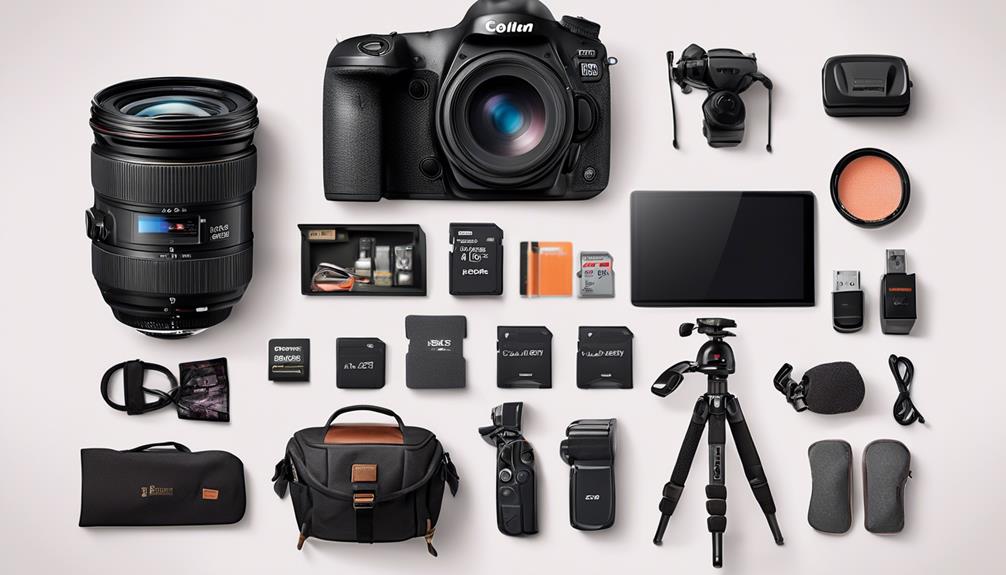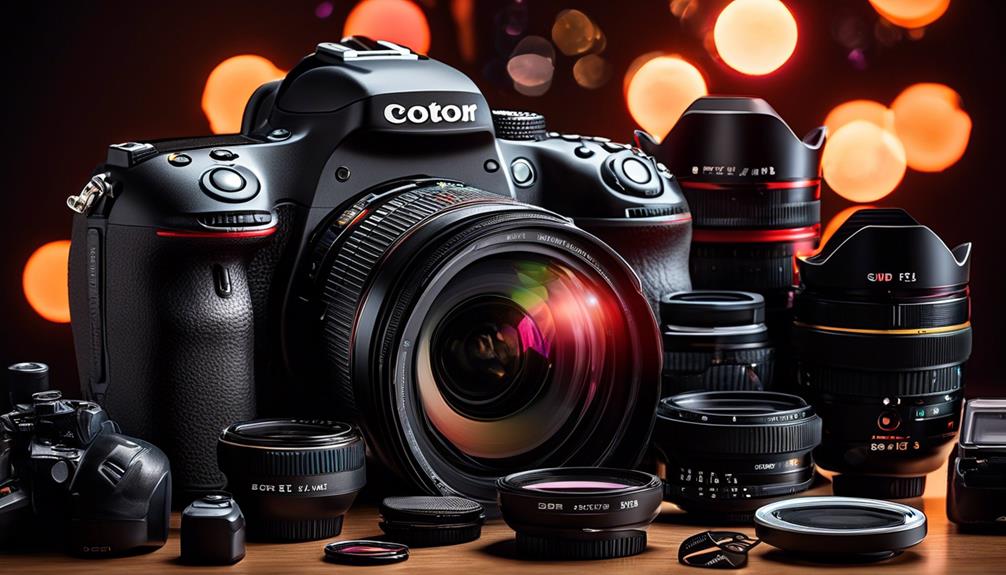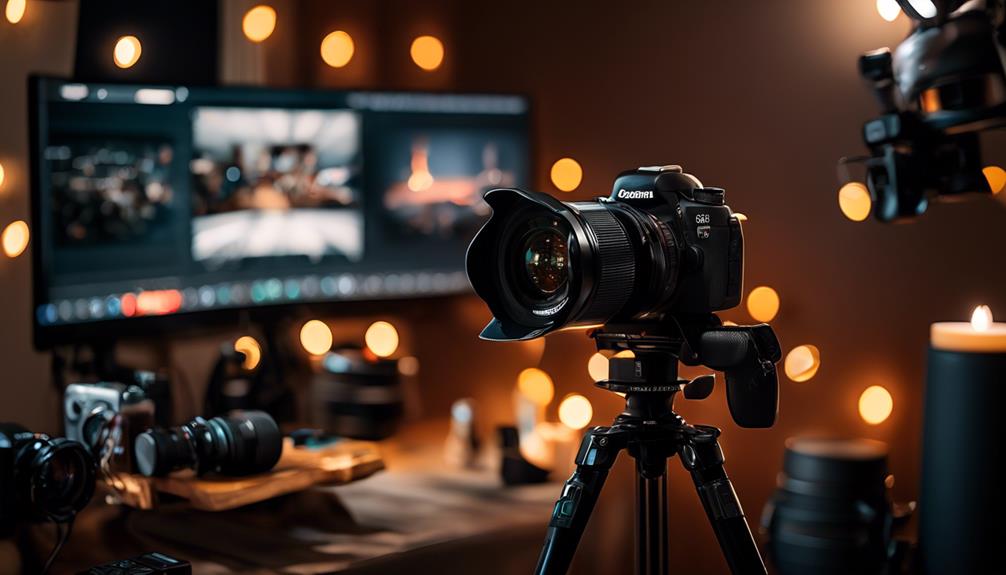Please note this post may contain affiliate links picked by me (Jay) that I have deemed may be of interest or relevant to you the reader of this.
These links do not affect the cost of the thing if you decide to purchase but i may get a little money if you choose to purchase.
For more information on my affiliate link policy click here.
As a newbie photographer, I can confidently say that the right gadgets can make all the difference in capturing those picture-perfect moments.
And let me tell you, the world of photography is full of incredible tools that can take your skills to the next level.
From camera lens filters that add a touch of magic to your shots, to tripods and monopods that ensure steady and blur-free images, there are so many options to explore.
But wait, there's more!
In this discussion, I'll be revealing the top 10 starter gadgets that every newbie photographer should consider.
Get ready to elevate your photography game and capture memories like never before.
Key Takeaways
- Camera lens filters, such as polarizing filters and neutral density filters, are essential for enhancing colors, reducing glare, and controlling light in different photography scenarios.
- Tripods and monopods provide stability and flexibility for different types of photography, with tripods offering maximum stability for long exposure shots and monopods being lightweight and quick to set up.
- External flash units and photography lighting equipment are crucial for manipulating and enhancing light in professional-looking images, offering control, diffusing light, and creating creative effects.
- Investing in storage and organization solutions, such as camera bags and cases, memory cards, and storage devices, is important for protecting gear, staying organized, and easily managing photos.
Camera Lens Filters
Camera lens filters are an essential tool for newbie photographers, allowing you to enhance your images and unleash your creativity. Two popular types of filters that every aspiring photographer should consider are polarizing filters and neutral density filters.
Polarizing filters are a game-changer when it comes to landscape and outdoor photography. They work by reducing glare and reflections, making colors more vibrant and the skies bluer. With a polarizing filter, you can capture stunning images of landscapes, water bodies, and even cityscapes with clear, crisp details. It's like adding a touch of magic to your photographs.
On the other hand, neutral density filters are perfect for controlling the amount of light that enters your camera. These filters come in handy when you want to achieve long exposure effects or capture motion blur in your images. By reducing the amount of light, neutral density filters allow you to use slower shutter speeds even in bright conditions, resulting in dreamy waterfalls, silky smooth seas, and streaking clouds.
Tripods and Monopods
When it comes to capturing steady and professional-looking shots, tripods and monopods are essential tools for photographers of all levels. These camera stabilizers provide stability and support, allowing photographers to eliminate camera shake and capture clear and sharp images. Whether you're a beginner or an experienced photographer, investing in a high-quality tripod or monopod can greatly enhance your photography skills.
Here is a comparison table of tripods and monopods to help you choose the right camera stabilizer for your needs:
| Tripods | Monopods |
|---|---|
| Provides maximum stability | Offers more flexibility and mobility |
| Ideal for long exposure shots and landscape photography | Perfect for sports and wildlife photography |
| Usually bulkier and heavier | Lightweight and compact |
| Requires more setup time | Quick and easy to set up |
While tripods are great for situations where stability is crucial, monopods offer versatility and ease of use. If you're constantly on the move or need to capture fast-action shots, a monopod might be the better option for you.
It's worth noting that there are other camera stabilizers available, such as selfie sticks, which are popular among smartphone photographers. However, for those looking for professional-quality shots, tripods and monopods are the go-to choices.
External Flash Units
Now let's move on to another essential gadget for newbie photographers: external flash units. When it comes to capturing stunning photographs, lighting plays a crucial role. That's where external flash units come in. These small devices pack a powerful punch, allowing you to control and manipulate light to create professional-looking images.
One feature that sets external flash units apart is the ability to use wireless triggers. Gone are the days of being limited by the length of your flash's cord. With wireless triggers, you can position your flash unit anywhere you want, giving you complete flexibility and control over your lighting setup. This innovation opens up a world of creative possibilities, allowing you to experiment with different lighting angles and techniques.
To further enhance your lighting setup, consider using flash diffusers. These handy accessories soften and spread the light emitted by your flash unit, resulting in more natural-looking images. By diffusing the harshness of the direct light, flash diffusers help reduce shadows and create a more pleasing and even illumination.
Camera Bags and Cases
I highly recommend investing in a quality camera bag or case to protect and organize your photography gear. As a newbie photographer, keeping your equipment safe and easily accessible is crucial, and a camera bag or case can provide just that.
There are various options available in the market, designed specifically to cater to the needs of photographers like you.
When it comes to camera bag organization, look for a bag that offers multiple compartments and dividers. This will allow you to keep your camera body, lenses, and accessories neatly organized and protected from scratches or damage. With designated spaces for each item, you'll never have to rummage through a messy bag again.
For those adventurous shoots in unpredictable weather conditions, waterproof camera cases are a must-have. These cases provide an extra layer of protection for your gear, keeping it safe from water damage. Whether you're shooting by the beach or in the rain, you can have peace of mind knowing that your equipment is well-protected.
Investing in a quality camera bag or case is a smart decision for newbie photographers. It not only safeguards your gear but also helps you stay organized during your photography journeys. So, don't hesitate to explore the various options available and find the perfect camera bag or case that suits your needs and style.
Happy shooting!
Remote Shutter Release
A remote shutter release is an essential tool that allows photographers to capture images without physically pressing the camera's shutter button. It's a game-changer for those looking to explore new perspectives and experiment with long exposures. With the advent of wireless triggers, photographers can now trigger their camera from a distance, giving them more flexibility and control over their shots.
Wireless triggers have revolutionized the way we capture images. Gone are the days of running back and forth to the camera, missing out on the perfect moment. With a remote shutter release, you can now capture stunning landscapes, breathtaking night skies, and even fast-paced action from a distance.
Additionally, remote shutter releases often come equipped with intervalometer settings, allowing photographers to set the camera to automatically take photos at specific intervals. This feature is particularly useful for time-lapse photography or capturing star trails. You can easily program your camera to take photos every few seconds, minutes, or even hours, giving you the freedom to concentrate on composing the perfect shot.
Investing in a remote shutter release won't only enhance your photography skills but also open up a world of creative possibilities. So, if you're a newbie photographer looking to take your shots to the next level, don't forget to add a remote shutter release to your starter gadgets.
Memory Cards and Storage Devices
Memory cards and storage devices are essential tools for photographers to store and manage their growing collection of high-quality images. As a newbie photographer, it's crucial to choose the right memory card and storage device that will meet your needs and allow you to capture and store your shots with ease.
Here are four innovative options to consider:
- Wireless transfer: With the advancement of technology, memory cards now come with built-in Wi-Fi capabilities, allowing you to wirelessly transfer your photos to your computer or smartphone. This eliminates the need for cables and makes the process seamless and convenient.
- Cloud storage: Storing your images in the cloud offers a secure and accessible solution. Cloud services like Dropbox, Google Drive, and iCloud allow you to back up and access your photos from anywhere, ensuring that your precious memories are always safe.
- High-capacity memory cards: As a newbie photographer, you'll want to invest in memory cards with ample storage space. Look for cards with high capacities, such as 64GB or 128GB, to ensure you never run out of storage during a shoot.
- Fast read and write speeds: To ensure smooth and efficient image capture, opt for memory cards with fast read and write speeds. This will allow your camera to quickly transfer data to the card, minimizing any delays and ensuring you never miss a shot.
Photography Lighting Equipment
Effective lighting is key to creating stunning photographs, and having the right photography lighting equipment can make all the difference in achieving professional-quality results. Whether you're shooting in a studio or outdoors, understanding different lighting techniques and utilizing natural light effectively can take your photography to the next level.
Here are some studio lighting techniques and natural light photography tips to help you capture amazing images:
| Studio Lighting Techniques | Natural Light Photography Tips |
|---|---|
| Use a softbox or umbrella to create soft, diffused light. | Shoot during the golden hour, when the sun is low in the sky, for warm and flattering light. |
| Experiment with different colored gels to add creative effects to your photos. | Utilize reflectors to bounce light and fill in shadows. |
| Incorporate a key light, fill light, and backlight to add depth and dimension to your subjects. | Position your subject near a window to take advantage of natural window light. |
| Consider using a light meter to ensure accurate exposure. | Use the Rule of Thirds to compose your shots and create visual interest. |
Camera Cleaning Kits
Now that you've mastered the art of lighting, it's time to ensure that your camera is always ready to capture those perfect shots with a high-quality camera cleaning kit.
Keeping your camera clean is essential for maintaining the quality of your images and prolonging the lifespan of your equipment.
Here are four must-have items for your camera cleaning kit:
- Sensor cleaning swabs: These specialized swabs are designed to safely remove dust and debris from your camera sensor. They're gentle yet effective, ensuring that your sensor remains spotless and free from any unwanted particles.
- Lens cleaning solution: A good lens cleaning solution is a must-have for any photographer. It helps to remove fingerprints, smudges, and other types of dirt that can affect the clarity of your images. Look for a non-abrasive solution that's specifically formulated for camera lenses.
- Microfiber cloths: These soft and lint-free cloths are perfect for gently wiping away dust and smudges from your camera body and lenses. They're safe to use on delicate surfaces and won't leave any scratches or marks.
- Air blower: An air blower is a handy tool for removing dust and debris from hard-to-reach areas of your camera. It uses a blast of air to dislodge particles without the need for direct contact, ensuring that your camera stays clean without the risk of damage.
With these essential camera cleaning kit items, you can ensure that your camera is always in top condition, ready to capture those stunning shots. Regular camera sensor cleaning and proper lens cleaning techniques won't only improve the quality of your images but also extend the life of your camera equipment.
Smartphone Camera Lenses
Smartphone camera lenses have revolutionized the way we capture and share moments, offering a whole new level of versatility and creativity to amateur and professional photographers alike. With the advancement of technology, smartphone photography techniques have evolved, and lenses have become an essential tool for enhancing the quality and range of our smartphone photos. These lenses come in various types, such as wide-angle, telephoto, and macro, allowing us to capture landscapes, distant subjects, and intricate details with precision.
One of the great things about smartphone camera lenses is their portability. They're small and lightweight, making them easy to carry around and attach to our smartphones whenever inspiration strikes. Additionally, many lenses are now compatible with multiple smartphone models, ensuring that we can continue using them even if we upgrade our devices.
To further enhance our smartphone photography, there are also editing apps available that allow us to fine-tune our images. These apps offer a wide range of features, such as filters, cropping tools, and adjustments for exposure, contrast, and saturation. With these editing apps, we can take our smartphone photos to the next level, transforming them into stunning works of art.
Photography Books and Guides
When it comes to improving your photography skills, one of the most valuable resources you can invest in is a photography book or guide. These books are like treasure troves of knowledge, offering insights into photography composition techniques and post-processing software recommendations.
Here are four top picks to help you take your photography to the next level:
- 'Understanding Exposure' by Bryan Peterson: This book is a must-have for beginners as it breaks down the fundamentals of exposure in a simple and easy-to-understand manner. You'll learn how to manipulate aperture, shutter speed, and ISO to capture stunning images in any lighting condition.
- 'The Photographer's Eye' by Michael Freeman: This guide delves into the art of composition, teaching you how to create visually compelling photographs. It explores topics like framing, balance, and leading lines, helping you develop an eye for capturing captivating images.
- 'Adobe Photoshop Lightroom Classic for Dummies' by Rob Sylvan: If you're interested in post-processing your photos, this book is a fantastic resource. It provides step-by-step instructions on using Adobe Lightroom Classic, a powerful software for editing and organizing your images.
- 'National Geographic Photography Field Guide: Secrets to Making Great Pictures' by Peter K. Burian and Bob Caputo: This comprehensive guide is packed with tips and techniques from National Geographic photographers. It covers everything from landscape photography to wildlife and portrait photography, offering invaluable insights into capturing stunning images.
Investing in these photography books and guides will provide you with a solid foundation and help you unleash your creativity. Happy shooting!
Frequently Asked Questions
What Are the Different Types of Camera Lens Filters and When Should They Be Used?
Camera lens filters come in various types and each has its own effect on photography. They can enhance colors, reduce reflections, and protect the lens.
UV filters are great for protecting the lens from scratches and dust.
Polarizing filters help reduce glare and enhance colors, making them ideal for outdoor shots.
Neutral density filters are perfect for long exposure photography, allowing you to capture motion blur or create smooth water effects.
Knowing when and how to use different filters can greatly enhance your photography skills.
How Do I Choose the Right Tripod or Monopod for My Photography Needs?
When it comes to choosing the right tripod or monopod for photography, there are a few factors to consider.
First, think about the weight and stability you need for your gear. Look for lightweight yet sturdy options.
Second, consider the height and adjustability of the tripod or monopod.
Finally, think about portability and ease of use.
Some top recommendations for beginners include the Manfrotto PIXI Mini Tripod and the AmazonBasics 67-Inch Monopod. These gadgets will provide stability and flexibility for your photography needs.
Happy shooting!
Can I Use an External Flash Unit With Any Camera Model?
Yes, you can definitely use an external flash unit with any camera model. It's one of the best starter gadgets for newbie photographers.
The compatibility of an external flash allows for greater control over lighting conditions, resulting in more professional-looking photos. The benefits of using an external flash include reducing red-eye, eliminating harsh shadows, and providing a more natural and balanced light.
It's a game-changer for capturing stunning images and unleashing your creativity.
What Features Should I Look for in a Camera Bag or Case to Protect My Equipment?
When it comes to choosing the right camera bag or case, there are a few factors you should consider.
First and foremost, you want to make sure it provides adequate protection for your precious photography gear. Look for a bag or case that has padding or compartments to keep your equipment safe and secure.
Additionally, consider the size and weight of the bag, as well as its durability and weather resistance.
Are Remote Shutter Releases Compatible With All Camera Brands and Models?
Wireless vs. wired remote shutter releases: which is better for beginners?
Well, I've to say that wireless remote shutter releases are a game-changer. They offer so much convenience and freedom when capturing shots.
However, it's important to note that compatibility can be an issue. If your camera brand or model doesn't support remote shutter releases, don't worry! There are third-party options available that can work with most cameras.
Conclusion
As a newbie photographer, having the right gadgets can make all the difference in capturing those perfect shots. From camera lens filters to photography lighting equipment, there are endless possibilities to enhance your skills and creativity.
So, get ready to dive into the world of photography with confidence and excitement.
Stay tuned for our next article where we reveal the secrets to capturing stunning images that will leave everyone in awe.
Happy shooting!


